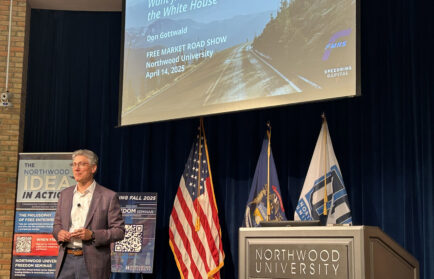By Dr. Timothy G. Nash
The U.S. economy is not as good as President Joe Biden has stated over the last year — nor is it as bad as many Republicans would argue it to be.
The U.S. unemployment rate is at a multi-decade low while job growth continues at a strong post-pandemic pace.
The December 2019 U.S. Employment Situation Report produced by the U.S. Bureau of Labor Statistics conveyed there were just over 158.8 million Americans employed. The COVID-19 recession wreaked havoc on the American economy. U.S. employment dropped dramatically to a recession trough of just over 133 million people by April 2020. Second quarter real U.S. GDP declined 29.9% — an all-time quarterly record decline, while third quarter 2020 real U.S. GDP rebounded in record fashion to a quarterly growth rate of 35.3%.
When the Employment Situation Report for December 2020 was released, total employment in the United States had rebounded to just over 149 million Americans employed. In December 2022, the U.S. economy finally realized overall employment – on a monthly basis — greater than that of December 2019. The Employment Situation Report showed total Americans employed in December 2022 was just over 159.2 million Americans. In our opinion, job recovery ended in December 2022, with total Americans employed surpassing pre-COVID-19 levels. This momentum continued into January 2023, with the Employment Situation Report showing 160.14 million Americans employed, or roughly 1.34 million net Americans employed since December 2019.
In our opinion, it is a bit of an exaggeration for President Biden to claim that he has created 12 million new jobs when many of the jobs were jobs recovered rather than new jobs created.
Another barometer of the U.S. economy that gives us cause for concern is the lack of recovery in new automobile, light truck, and SUV sales. In 2019, 16.85 million automobiles, light trucks, and SUVs were sold in the United States, according to Statista. Edmunds has forecasted 14.8 million automobiles, light trucks, and SUVs will be sold in the United States in 2023 (Cox Automotive estimates the number could be as high as 15.5 million vehicles).
In the best-case scenario, we are selling 1.5 million fewer automobiles, light trucks, and SUVs in the U.S. in 2023 relative to 2019. This clearly means we are still having supply chain issues and/or a declining demand in this vital segment of the U.S. economy. New car prices were up 6.3% in January, which leads us to believe demand, at least in the short run, is still strong and the major issue is supply chain-related adversely impacting the production of vehicles.
Key U.S. data from the federal government shows the annualized U.S. inflation rate for January 2023 was 6.4%, as measured by the Consumer Price Index (CPI), down from 6.5% in December and substantially lower than its 2022 high of 9.1% but much higher than the Federal Reserve long run target of 2%. Adding to our concern, the Producer Price Index (PPI) came in well above expectations for January. The January rates were not received well by many on Wall Street as they were hoping for a more substantial decline in inflation.
Many worry that the Federal Reserve’s Open Market Committee will increase the Federal Funds Rate by a half percent in March, driving interest rates on everything from motor vehicle loans to home mortgages upward, putting new and existing home sales into an even deeper recession, while further slowing sales of new automobiles, light trucks, and SUVs.
Current Issues
In a recent Wall Street Journal editorial, “Biden’s federal budget blowout,” it was noted “If you are a socialist and want the government to control more of the means of production in the U.S. economy, Joe Biden is your man.” Based on CBO data, we believe the Wall Street Journal is correct. The solution for the economy, according to the Biden administration, is that more government spending and higher taxation of individuals and corporations will lead to an average growth in U.S. GDP of only 1.8% between now and 2033, based on CBO projections.
We believe it is time to cut government spending, reduce unnecessary regulations and cut taxes on individuals and businesses, to unleash the American competitive free enterprise system and the entrepreneurs who are the backbone of economic growth and change.
We believe economic policies that create entrepreneurs and new businesses will restore U.S. economic growth to its pre-Great Recession, post-World War II growth rate of 3.3%.
About the author:
Dr. Timothy G. Nash is Vice President, Emeritus; Director of The McNair Center for the Advancement of Free Enterprise and Entrepreneurship; and the McNair Endowed Chair in Free Market Economics at Northwood University.
Tim Nash joined Northwood in 1980 and received a B.B.A. from the university, an M.A. in Economics from Central Michigan University, and his doctorate from Wayne State University. Dr. Nash leads economic research at Northwood University. His travels and research have taken him to over 30 countries from China and Mexico to Poland and Switzerland where he has also participated in research and academic colloquiums.
Dr. Nash is a former adjunct scholar with the Mackinac Center for Public Policy in Midland, an adjunct scholar with the American Legislative Exchange Council (ALEC) in Washington, D.C., and is the former State Director of Economic Education for the clergy for the State of Michigan.
He has co-authored four books including When We Are Free (with foreword by Dr. Milton Friedman) and In Defense of Capitalism (co-authored with Dr. Richard M. Ebeling, and Dr. Kent D. MacDonald).
Nash and his colleagues have conducted research and consulting for a number of Fortune 500 companies and their industry associations including GM/UAW/PEL, the National Automobile Dealers Association (NADA), the Motor & Equipment Manufacturers Association (MEMA), Auto Care Association (ACA), the Michigan Chamber of Commerce Foundation, Chrysler, and Dow Corning Corporation.
Dr. Nash is responsible for researching and publishing the Northwood University Annual Economic Forecast, Northwood’s Monthly Economic Outlook, a portion of the Auto Care Association’s annual Factbook as well as the model for its monthly Business and Economic Confidence Indexes which are done in conjunction with Northwood University.
Nash has periodically led a team of economists from across the country to produce the highly regarded Michigan Economic Competitiveness Report, which compares Michigan to 49 other states on economic competitiveness. Nash’s team has also conducted the study for the Illinois, West Virginia, Texas Chambers of Commerce and is currently conducting the study for the state of Ohio.
Dr. Nash has addressed national and international forums related to the economy and automobile industry in China, Mexico, Canada, across Europe and throughout the United States. He serves on the boards of the Free Enterprise Institute (FEI) in Houston, Texas, Junior Achievement of Central Michigan, Gerace Construction Incorporated and Mid-Michigan Regional Health.
Nash is a frequent guest on Michigan-based ABC, NBC, FOX and CBS television stations, WWJ WJR, WSGW and WTCM radio stations . His writing and interviews have appeared in publications as diverse as The Detroit News, The Philadelphia Inquirer, Midland Daily News, Automotive News, Aftermarket Business, Aftermarket News, The New Jersey Star Ledger, USA Today, the Chicago Tribune, CNBC, Yahoo Finance, Wall Street Journal/MarketWatch, Townhall, The Federalist, National Review, AIER, International Review of Economics and Harvard University’s Better, Faster, Cheaper.
Dr. Nash resides in Midland, MI with his wife, Pam, and is the father of four adult children and grandfather to Ella, John George, Brady, Caroline, Evelyn, Bennett, Oliver, Gabriel, Graham, Cecilia, Olivia and Genevieve — his pride and joy!





